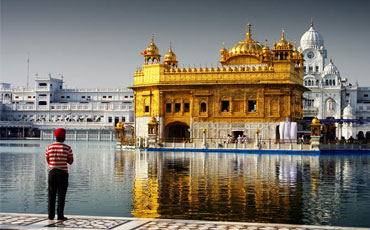
Sri Harmandir Sahib, also known as Sri Darbar Sahib or Golden Temple, (on account of its scenic beauty and golden coating for English speaking world), is named after Hari (God) the temple of God. The Sikhs all over the world, daily wish to pay visit to Sri Amritsar and to pay obeisance at Sri Harmandir Sahib in their Ardas.
Guru Arjan Sahib, the Fifth Nanak, conceived the idea of creating a central place of worship for the Sikhs and he himself designed the architecture of Sri Harmandir Sahib. Earlier the planning to excavate the holy tank (Amritsar or Amrit Sarovar) was chalked out by Guru Amardas Sahib, the Third Nanak, but it was executed by Guru Ramdas Sahib under the supervision of Baba Budha ji. The land for the site was acquired by the earlier Guru Sahibs on payment or free of cost from the Zamindars (landlords) of native villages. The plan to establish a town settlement was also made. Therefore, the construction work on the Sarovar (the tank) and the town started simultaneously in 1570. The work on both projects completed in 1577 A.D.
The land for the site was bought by the Guru Ram Das Sahib on payment from the Zamindars (landlords) of native villages.
Rare Old Photograph of Sri Harmandir Sahib The Golden Temple Amritsar Guru Arjan Sahib got its foundation laid by a muslim saint Hazrat Mian Mir ji of Lahore on 1st of Magh, 1645 Bikrmi Samvat (December, 1588). The construction work was directly supervised by Guru Arjan Sahib himself and he was assisted by the prominent Sikh personalities like Baba Budha ji, Bhai Gurdas ji, Bhai Sahlo ji and many other devoted Sikhs.
Unlike erecting the structure on the higher level (a tradition in Hindu Temple architecture), Guru Arjan Sahib got it built on the lower level and unlike Hindu Temples having only one gate for the entrance and exit, Guru Sahib got it open from four sides. Thus he created a symbol of new faith, Sikhism. Guru Sahib made it accessible to every person without any distinction of Caste, creed, sex and religion.
The building work completed in 1601 A.D. on Bhadoon Sudi 1st, 1661 Bikrmi Samvat (August/September,1604). Guru Arjan Sahib installed newly created Guru Granth Sahib, in Sri Harmandir Sahib and appointed Baba Budha ji as its first Granthi i.e. the reader of Guru Granth Sahib. After this event it attained the status of 'Ath Sath Tirath'. Now the Sikh Nation had their own Tirath, a pilgrimage center
Old Photograph of Sri Harmandir Sahib The Golden Temple AmritsarSri Harmandir Sahib, is built on a 67ft. square platform in the centre of the Sarovar(tank). The temple itself is 40.5ft. square. It has a door each on the East, West, North and South. The Darshani Deori (an arch) stands at the shore end of the causeway. The door frame of the arch is about 10ft in height and 8ft 6inches in breath. The door panes are decorated with artistic style. It opens on to the causeway or bridge that leads to the main building of Sri Harmandir Sahib. It is 202 feet in length and 21 feet in width.
The bridge is connected with the 13 feet wide 'Pardakshna' (circumambulatory path). It runs round the main shrine and it leads to the 'Har ki Paure' (steps of God). On the first floor of "Har Ki Pauri", there is continuous reading of Guru Granth Sahib.
The main structure of Sri Harmandir Sahib, functionally as well as technically is a three-storied one. The front, which faces the bridge, is decorated with repeated cusped arches and the roof of the first floor is at the height of the 26 feet and 9 inches.
At the top of the first floor 4 feet high parapet rises on all the sides which has also four 'Mamtees' on the four corners and exactly on the top of the central hall of the main sanctuary rises the third story. It is a small square room and have three gates. A regular recitation of Guru Granth Sahib is also held there.
On the top of this room stands the low fluted 'Gumbaz'(dome) having lotus petal motif in relief at the base inverted lotus at the top which supports the "Kalash" having a beautiful "Chhatri" at the end.
Its architecture represents a unique harmony between the Muslims and the Hindus way of construction work and this is considered the best architectural specimens of the world. It is often quoted that this architecture has created an independent Sikh school of architecture in the history of art in India.
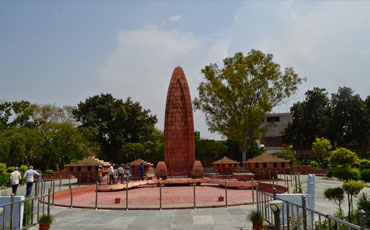
Jallianwala Bagh is a public garden in Amritsar famous for one of the most tragic yet landmark events in the history of India. This is where the Amritsar Massacre of 1919 took place.
The British Army soldiers upon receiving orders from General Dyer opened fire on a huge, unarmed gathering of men, women and children on April 13, 1919.
There is a well inside Jallianwala Bagh into which many people including children jumped to save themselves from the firing. The garden also houses a memorial built in honour of the massacre victims. The portion of the wall with bullet marks along with the well is preserved as a memorial. A light and sound show is hosted here every evening. The act, narrated using actor Amitabh Bachhan’s voice, recreates the events of 1919 that took place at Jallianwala Bagh and is quite an interesting and stirring experience. But don’t forget to bring mosquito repellent if you plan to attend the show!
Jallianwala Bagh is situated close to the Golden Temple and is a must visit when in Amritsar.
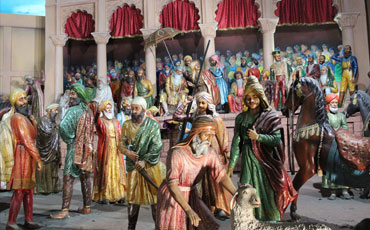
Maharaja Ranjit Singh Museum was the erstwhile summer palace of Maharaja Ranjit Singh, the first ruler of the Sikh Empire. The museum displays articles related to Maharaja Ranjit Singh, old paintings, manuscripts and coins, which are centuries old. The museum makes for a fascinating visit especially for those interested in history.
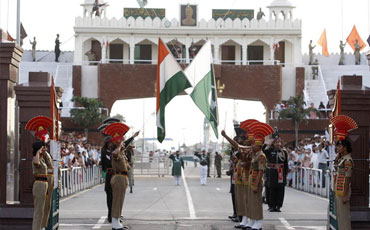
The only road border crossing between India and Pakistan, Wagah lies between Amritsar in India and Lahore in Pakistan, and is located approximately 30 kilometres away from the city.
It is home to the Radcliffe Line, which is the demarcation between India and Pakistan and was drawn during the partition of India in 1947. The illustrious lowering of the flags ceremony takes place here at the Wagah Border; a daily military practice followed by the Border Security Force (BSF) and the Pakistan Rangers, since 1959.
Wagah Border attracts crowds in large numbers including elderly people, children and foreign nationals. From shouts of patriotism, to the powerful show put up by the BSF and Pakistan Rangers, a visit to Wagah is a gripping experience.
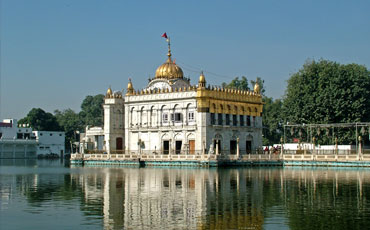
An important Hindu temple situated in the city of Amritsar, Durgiana Temple is devoted to Goddess Durga. It is also known as the Lakshmi Narayan Temple and was built during the 16th century. Similar to the sarovar in Golden Temple, there is also a water tank or lake surrounding the main temple construction.
Travel Tip: Try scheduling your visit during the aarti (prayer ceremony) for a truly wonderful experience at this beautiful temple.
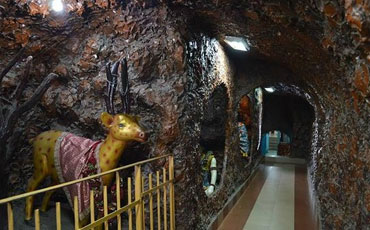
Mata Lal Devi temple was built on the lines of the sacred Vaishnodevi temple in Jammu. The temple is the shrine of 20th century female saint Mata Lal Devi Ji popularly known as ‘Pujya Mata Ji’. The temple houses many statues of gods and goddesses with the sacred seat of Pujya Mata Ji in the centre. One of the exciting aspects of the temple is the fact that you have to walk across caves and little water channels. One of the most popular attractions at the temple is the ‘Gufa Vaishno Devi Ji’. Free food is served to visitors at the temple.
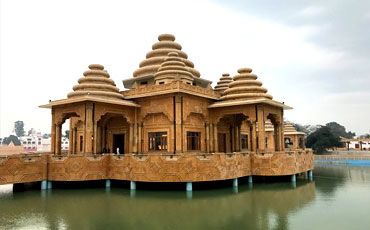
Sri Ram Tirath Temple is dedicated to the Hindi god – Lord Rama. The temple complex contains a hut and a tank. The temple is believed to be at the place where sage Valmiki had his ashram. According to Hindu mythology, Valmiki gave shelter to Goddess Sita in his ashram and she gave birth to her sons, Luv and Kush, in the hut . The tank is believed to have been dug by Lord Hanuman.
Hindu mythology also states that the epic fight between Luv-Kush and their father, Lord Rama, took place at Ram Tirath.